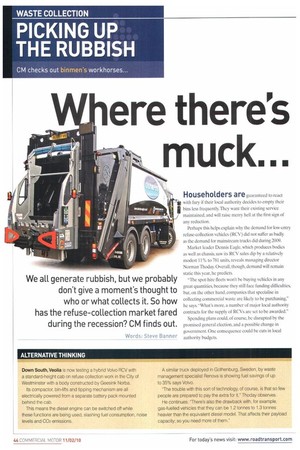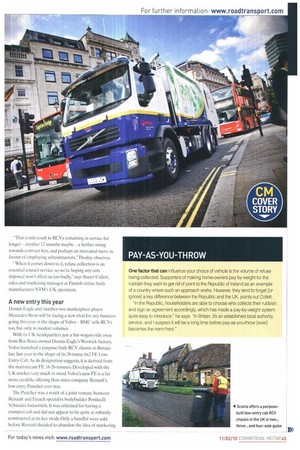ere there's muck...
Page 44

Page 45

Page 46

Page 47

If you've noticed an error in this article please click here to report it so we can fix it.
We all generate rubbish, but we probably don't give a moment's thought to who or what collects it. So how has the refuse-collection market fared during the recession? CM finds out.
Words: Steve Banner Householders are guaranteed to react with fury if their local authority decides to empty their bins less frequently. They want their existing service maintained, and will raise merry hell at the first sign of any reduction.
Perhaps this helps explain why the demand for low-entry refuse-collection vehicles (RCV) did not suffer as badly as the demand for mainstream trucks did during 2009.
Market leader Dennis Eagle, which produces bodies as well as chassis, saw its RCV sales dip by a relatively modest 11% 10 781 units, reveals managing director Norman Thoday. Overall, though, demand will remain static this year, he predicts.
"The spot-hire fleets won't he buying vehicles in any great quantities, because they still face funding difficulties, hut, on the other hand, companies that specialise in collecting commercial waste are likely to be purchasing,he says. -What's more, a number of major local authority contracts for the supply of RC,'Vs are set to be awarded."
Spending plans could, of course, be disrupted by the promised general election, and a possible change in government. One consequence could be cuts in local authority budgets.
That could result in RCVs remaining in service for longer another 12 months maybe a further swing towards contract hire, and perhaps an increased move in favour of employing subcontractors,"Thoday observes.
"When it conies down to it, refuse collection is an essential council service, so we're hoping any cuts imposed won't affect us too badly," says Stuart Collett, sales and marketing manager at Finnish refuse body manufacturer NTM's UK operation.
A new entry this year
Dennis Eagle and number-two marketplace player Mercedes-Benz will be facing a new rival for any business going this year in the shape of Volvo BMC sells RCVs too, but only in modest volumes.
With its UK headquarters just a bin-wagon-ride away from Ros Roca-owned Dennis Eagle's Warwick factory, Volvo launched a purpose-built RCV chassis in Britain late last year in the shape of its 26-tonne 6x2 FE LowEntry Cab. As its designation suggests, it is derived from the mainstream FE 15-26-tonners. Developed with the UK market very much in mind, Volvo's new FE is a far more credible offering than sister company Renault's low-entry Puncher ever was
The Puncher was a result of a joint venture between Renault and French specialist bodybuilder Ponticelli Vehicules I ndustriels. It was criticised for having a cramped cab and did not appear to he quite as robustlyconstructed as its key rivals. Only a handful were sold before Renault decided to abandon the idea of marketing it on this side of the Channel. Incidentally, Scania also offers a purpose-built low-entry cab RCV chassis in the UK in two-, three-, and four-axle guise.
Volvo Trucks UK managing director Goran Nyberg reveals: "We've got the capacity to supply 150 annually.
"That's our sales target, and if we can increase that number, we will."
Achieving its goal would give it 10% of a sector typically worth 1500 registrations annually, and with a product whose design has been very much driven by the manufacturer's British operation.
RCVs sometimes have a rear overhang that is so long the vehicle's out-swing can be substantial. A driver's difficulties may be further compounded by bin-lifting equipment that is narrower than the body, and which they cannot see in their rear-view mirrors, says Volvo sales engineer Martin Kelly. Rear vision is especially important given that crew members will be working at the back of the vehicle. As a consequence, reversing cameras are now standard on many RCVs.
Low-entry 26-tonne RCVs are usually powered by a 300hp or thereabouts diesel that is invariably married to an automatic gearbox. An auto 'box is ideal for the gruelling stop-start work that such trucks are engaged in, but that is not the only reason for installing them, Kelly adds. "They allow a power take-off to be fitted that will operate the compactor while the vehicle is on the move," he explains. "Try to do so with a PTO on a manual gearbox and you'll stall the vehicle.
An auto 'box has the added bonus that it helps protect the vehicle from unnecessary abuse. Drivers can come under pressure to cut corners and get the round completed as soon as possible and that could result in damage to the vehicle's clutch if a manual 'box was fitted.
Waste of time?
Some pundits question whether low-entry cabs are really necessary. "On a lot of urban and suburban bin rounds, the crew climb out of the wagon at the start of the round and walk alongside it, collecting and emptying the bins and putting them back.They only climb back in when the body is full and the wagon goes off to the waste transfer station," observes an industry executive.
Not surprisingly, this is a view Thoday does not share.
"Drivers and other crew members are in and out of the cab a lot more than people realise, and a truck cab is some distance from the ground," he points out.That means there is a potential risk of injury that employers and their employees would rather avoid.
Conscious of the need to cut their carbon footprint, a number of refusecollection concerns are exploring the use of alternative fuels Leeds City Council, for example, is operating a Mercedes-Benz Econic that runs on bin-gas produced from waste matter in the South of England. It is achieving a 60% reduction in CO2 emissions says the authority, even when the carbon cost of transporting the fuel north is taken into account.
"That figure could be significantly improved in the future if we are able to run it on gas from a local source:.
says Terry Pycroft, the authority's head of fleet services The Econic in question is a 2628LEG 6x2 26-tonner with a rear-steer axle — the first RCV of its type to go into service in the UK. It was acquired by the council following a six-month trial.
Carbon measurement
The Econic's arrival was the result of work carried out by the authority and the Energy Saving Trust to measure the carbon footprint of the former's 1,200-strong fleet and pinpoint areas where reductions could be made.
"The investigation showed it was RCVs that made the biggest contribution to our carbon output," Pycroft says. "They only average around 2.5mpg because their engines are constantly running to drive the bin lifts and compaction equipment.The trust's report suggested ways in which we could cut our emissions, including using alternative fuels." he adds. So we decided to investigate that further."
Pycroft does concede that




































































































































